|

Burma, Summer 2000
Join us as we encounter monks and temples, remote mountain villages, Nobel
Peace Prize Winner Aung San Suu Kyi, and flee from the Burmese military
Page 1 of 2


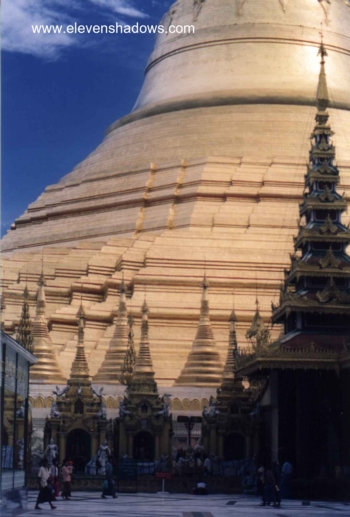 Shwedagon
Paya, Yangon (Rangoon), Myanmar (Burma). The original stupa was built
sometime between the 6th and 10th centuries and, according to legend, houses
eight hairs of the Buddha. Shwedagon
Paya, Yangon (Rangoon), Myanmar (Burma). The original stupa was built
sometime between the 6th and 10th centuries and, according to legend, houses
eight hairs of the Buddha. |
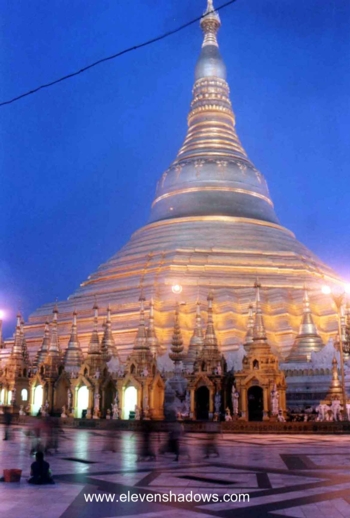 Shwedagon
Paya lit up in the evening. I left my tripod in the hotel, so I ended up
taking this picture by balancing the camera on my backpack, which was
resting on a railing. Shwedagon
Paya lit up in the evening. I left my tripod in the hotel, so I ended up
taking this picture by balancing the camera on my backpack, which was
resting on a railing. |
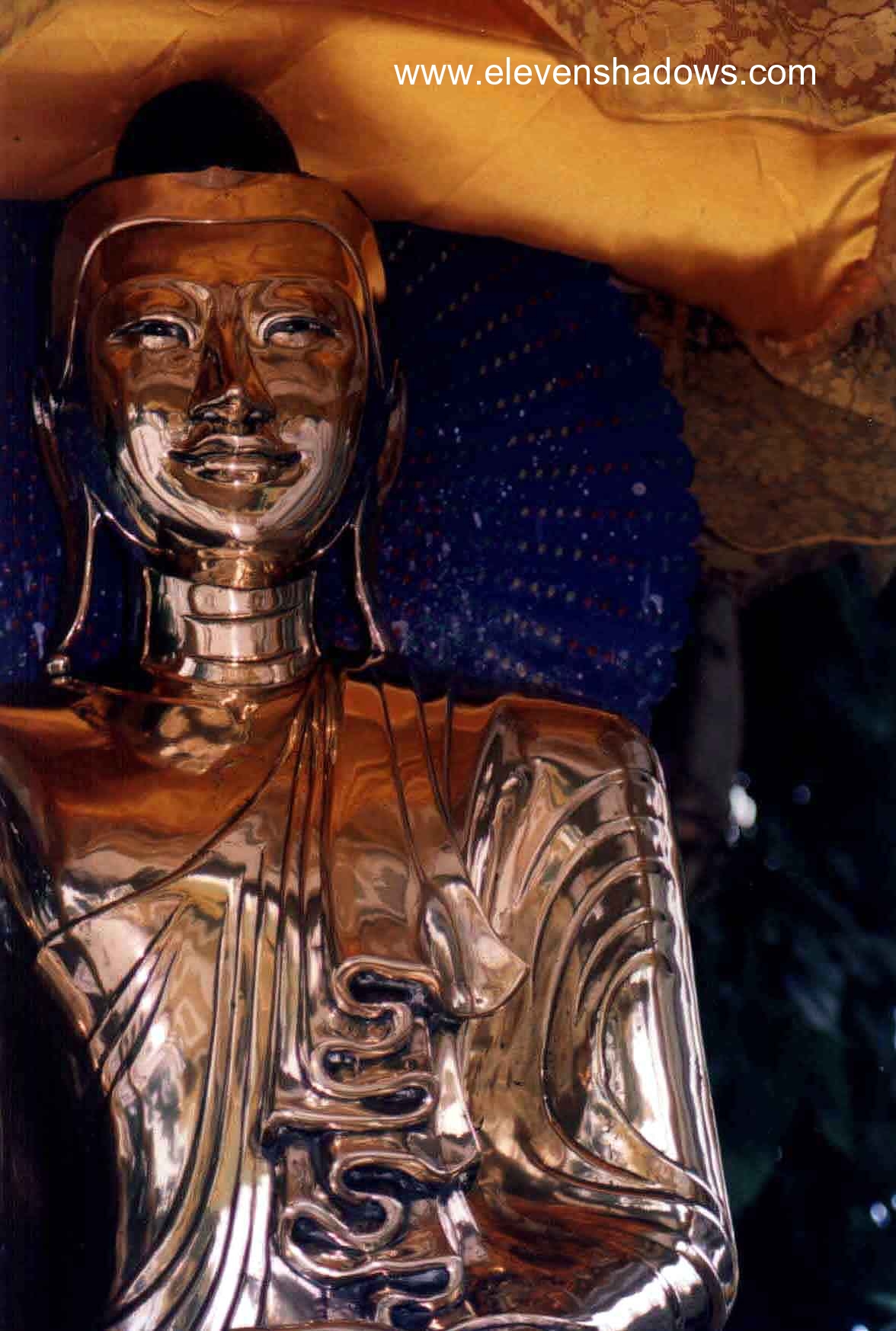 One
of the many buddhas at Shwedagon Paya, Yangon, Myanmar. A vast assortment of
smaller temples, shrines, statues and pavilions surround the main building. One
of the many buddhas at Shwedagon Paya, Yangon, Myanmar. A vast assortment of
smaller temples, shrines, statues and pavilions surround the main building. |
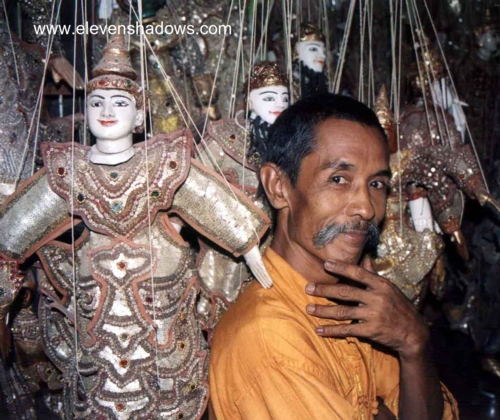 Lu
Maw, of the Moustache Brothers troupe, in Mandalay. The Moustache Brothers
perform an interesting blend of music, drama, improvisation, and social
commentary/satire known as pwe. Two members of the troupe -- Par Par Lay and
Lu Zaw, Lu Maw’s older brother and cousin, respectively -- were arrested in
1996 after performing at an NLD gathering and telling jokes about the
government. Par Par Lay’s wife travels to the prison every two months to
bring him food, although she is not allowed to see him. A visit to the
nightly performances on 39th St is highly recommended. Lu
Maw, of the Moustache Brothers troupe, in Mandalay. The Moustache Brothers
perform an interesting blend of music, drama, improvisation, and social
commentary/satire known as pwe. Two members of the troupe -- Par Par Lay and
Lu Zaw, Lu Maw’s older brother and cousin, respectively -- were arrested in
1996 after performing at an NLD gathering and telling jokes about the
government. Par Par Lay’s wife travels to the prison every two months to
bring him food, although she is not allowed to see him. A visit to the
nightly performances on 39th St is highly recommended. |
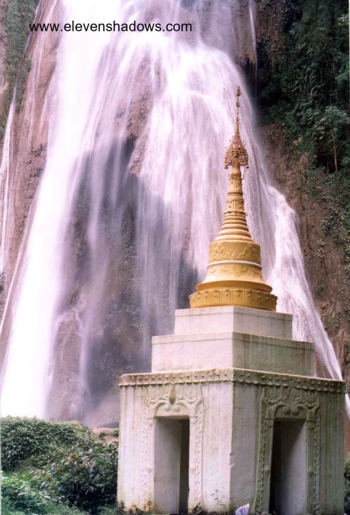 A
waterfall near Pyin U Lwin, a town that continues to use stagecoaches left
over from the British occupation of Myanmar. A
waterfall near Pyin U Lwin, a town that continues to use stagecoaches left
over from the British occupation of Myanmar. |
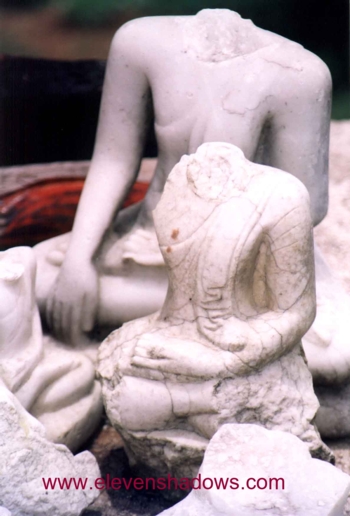 Headless
buddhas at a monastery in Hsipaw, Myanmar Headless
buddhas at a monastery in Hsipaw, Myanmar |
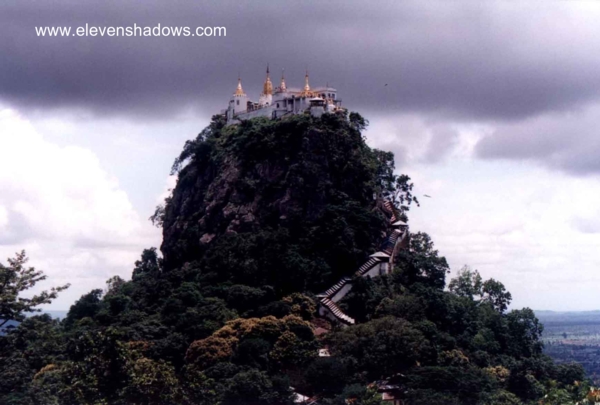 Mt.
Popa, the Mt. Olympus of nats (spirits). Before King Anawrahta brought
Buddhism to Burma in the 11th century, the Burmese worshipped
nats, spirits who held dominion over specific places, people, and fields of
endeavor. When nats were displaced by buildings or monasteries, the Burmese
often built small shrines to appease them, lest they cause misfortune to
befall the human landowners. Mt.
Popa, the Mt. Olympus of nats (spirits). Before King Anawrahta brought
Buddhism to Burma in the 11th century, the Burmese worshipped
nats, spirits who held dominion over specific places, people, and fields of
endeavor. When nats were displaced by buildings or monasteries, the Burmese
often built small shrines to appease them, lest they cause misfortune to
befall the human landowners.human landowners. Anawrahta’s attempt to
stamp out nat worship in favor of Buddhism simply resulted in the Burmese
practicing nat worship in secret, rebuilding the shrines in their homes. The
king, realizing that he was driving people away from Buddhism, added a new
nat king to the nat pantheon that outranked the previous king and paid
homage to Buddha – thus making all nats subordinate to Buddha. Today, nat
worship coexists with Buddhism, and nats are often seen in Buddhist temples
throughout the country. |
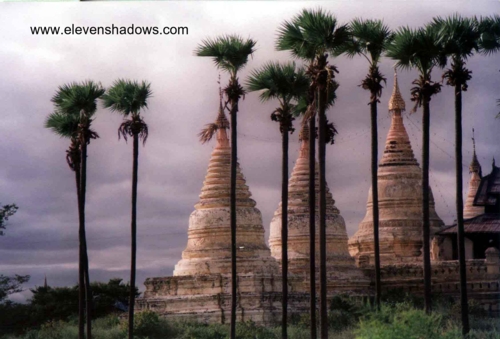 Bagan.
We bicycled around this spectacular plain of monuments, many over 800 years
old. The area encompasses 40 sq. km. This is often considered to be one of
the most remarkable sites in Myanmar, if not all of Southeast Asia. Bagan.
We bicycled around this spectacular plain of monuments, many over 800 years
old. The area encompasses 40 sq. km. This is often considered to be one of
the most remarkable sites in Myanmar, if not all of Southeast Asia. |
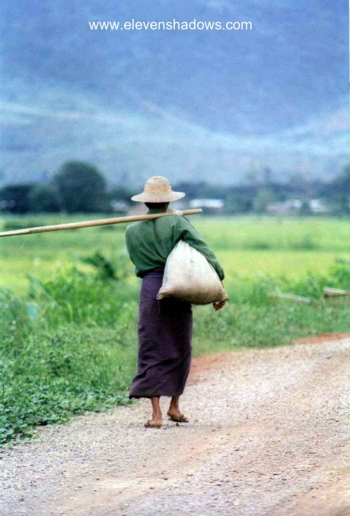 Walking
between villages near Nyaungshwe, Inle Lake, Myanmar. The Inle Lake area
sits in a green, picturesque valley flanked by tall mountains in the Shan
State of Myanmar. The lake itself features floating gardens and charming
villages built entirely on stilts, inhabited by Intha people. The incredibly
tasty mangos, bananas, and tomatoes, as well as the village life, reminded
me a little of Dal Lake in Srinagar. Rather strange is how the Inthas paddle
their boats—standing at the stern on one leg while wrapping the other leg
around the oar to offer relief for the arms. Inle Lake offers beautiful
mountain hikes, wonderful food, and very friendly people, and was perhaps
our favorite location in Myanmar. Walking
between villages near Nyaungshwe, Inle Lake, Myanmar. The Inle Lake area
sits in a green, picturesque valley flanked by tall mountains in the Shan
State of Myanmar. The lake itself features floating gardens and charming
villages built entirely on stilts, inhabited by Intha people. The incredibly
tasty mangos, bananas, and tomatoes, as well as the village life, reminded
me a little of Dal Lake in Srinagar. Rather strange is how the Inthas paddle
their boats—standing at the stern on one leg while wrapping the other leg
around the oar to offer relief for the arms. Inle Lake offers beautiful
mountain hikes, wonderful food, and very friendly people, and was perhaps
our favorite location in Myanmar. |
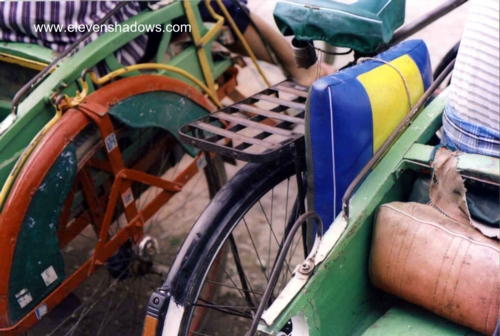 Cycle
rickshaws are a common method of transportation in Inle Lake and much of
Myanmar. Automobile traffic is still rather light. Cycle
rickshaws are a common method of transportation in Inle Lake and much of
Myanmar. Automobile traffic is still rather light. |
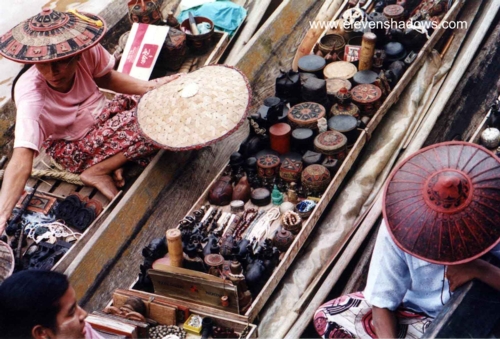 Besieged
by hawkers in souvenir boats, Inle Lake, Myanmar. Besieged
by hawkers in souvenir boats, Inle Lake, Myanmar. |
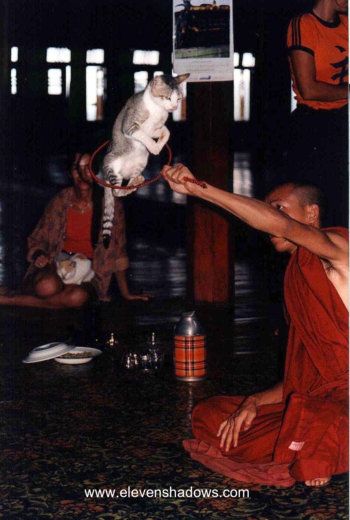 What
is the sound of one cat jumping? This is Nga Phe Kyaung, also known as
Jumping Cat Monastery, in Inle Lake. When not meditating on the nature of
emptiness, monks teach cats to jump through hoops. What
is the sound of one cat jumping? This is Nga Phe Kyaung, also known as
Jumping Cat Monastery, in Inle Lake. When not meditating on the nature of
emptiness, monks teach cats to jump through hoops. |
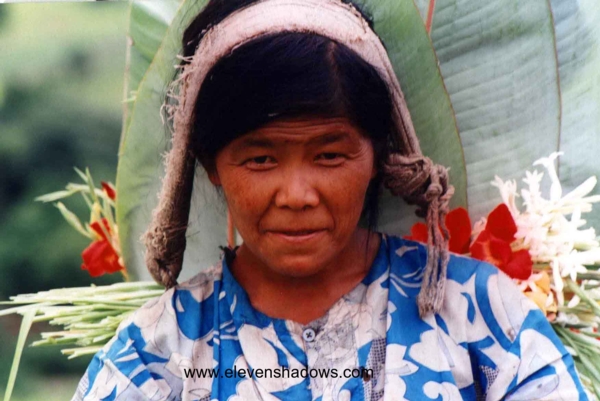 We
visited several Pa-O villages and a meditation cave during a very
picturesque 13.5-mile hike in the mountains east of Nyaungshwe. Many of the
villagers, such as the woman here, carry food they’ve grown to the larger
market in Nyaungshwe. Some walk as much as 20 miles with 60 pounds on their
backs – while wearing flip-flops. We
visited several Pa-O villages and a meditation cave during a very
picturesque 13.5-mile hike in the mountains east of Nyaungshwe. Many of the
villagers, such as the woman here, carry food they’ve grown to the larger
market in Nyaungshwe. Some walk as much as 20 miles with 60 pounds on their
backs – while wearing flip-flops. |
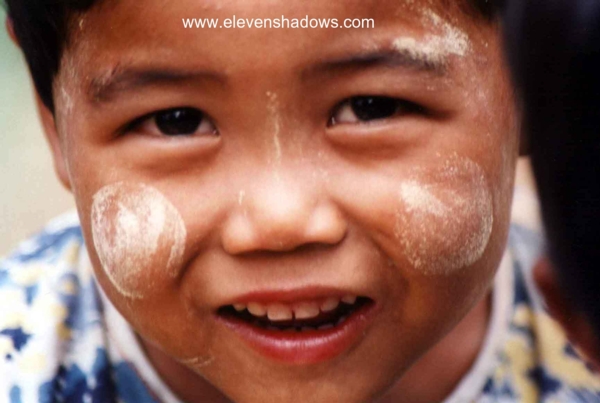 Pa-O
boy in a mountain village near Nyaungshwe, showing a particular fascination
with my camera. Pa-O
boy in a mountain village near Nyaungshwe, showing a particular fascination
with my camera.
As we continued up the mountain to the more remote
villages, the children ran screaming when they saw us coming.
I asked Win, our guide, what the villagers thought was
most unusual about our appearance. Without pausing to think, he
replied, "Big shoes and white skin."
Our appearance was quite different. Indeed, the Burmese
frequently refer to Caucasians as "Long Noses". Even though I am
Chinese, I was still freakishly tall, wearing strange clothes and enormous
shoes. |
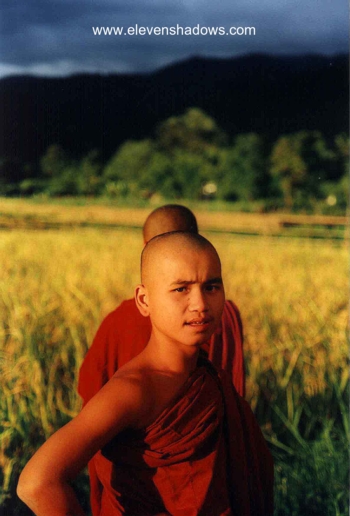 Like
this young monk, most Burmese belong to the Theravada sect of Buddhism.
After one of the monsoon rains over the valley and Inle Lake, we were
rewarded with a rainbow and a spectacular sunset over the mountains, bathing
everything in golden light. Like
this young monk, most Burmese belong to the Theravada sect of Buddhism.
After one of the monsoon rains over the valley and Inle Lake, we were
rewarded with a rainbow and a spectacular sunset over the mountains, bathing
everything in golden light. |
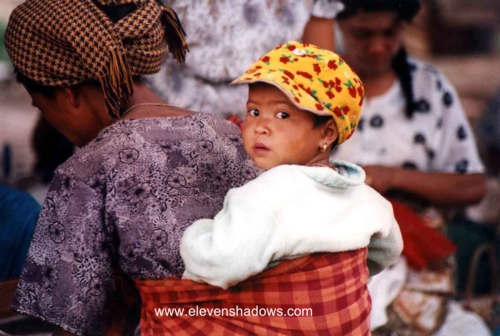 Market
in the town of Pindaya. Market
in the town of Pindaya. |
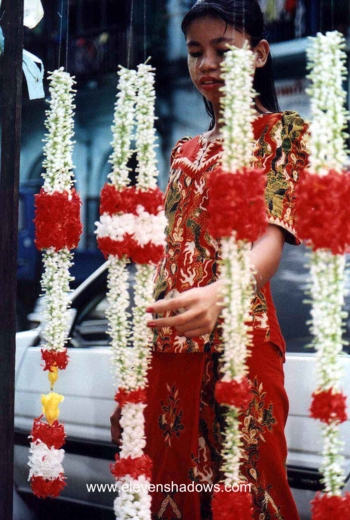 Outside
a Hindu temple in Yangon, Myanmar, a girl sells garlands to be given as
offerings. About 1.5 percent of Burmese are Hindu, and most are of Indian
descent. Outside
a Hindu temple in Yangon, Myanmar, a girl sells garlands to be given as
offerings. About 1.5 percent of Burmese are Hindu, and most are of Indian
descent. |
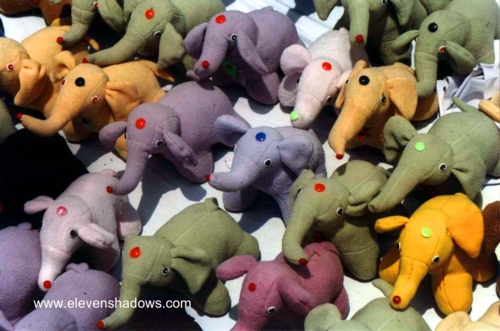 Yangon,
Burma. Yangon,
Burma. |
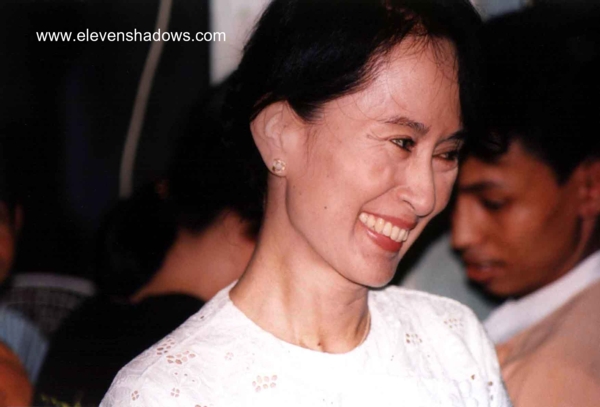 Aung
San Suu Kyi, Nobel Peace Prize winner, leader of the National League for
Democracy, and the democratically elected leader of Myanmar. After being
under house arrest for six years, she now has limited freedom but cannot
leave Yangon. Her father, General Aung San, was the first leader of Burma’s
independence movement and was assassinated in 1947. Aung
San Suu Kyi, Nobel Peace Prize winner, leader of the National League for
Democracy, and the democratically elected leader of Myanmar. After being
under house arrest for six years, she now has limited freedom but cannot
leave Yangon. Her father, General Aung San, was the first leader of Burma’s
independence movement and was assassinated in 1947.
While returning from the Martyrs Day events at the Arzani
Mausoleum commemorating General Aung San’s death, we saw a large crowd
outside a building adorned with large red banners with Burmese words and
English words saying "National League for Democracy". Intrigued, we wandered
over and were told that Aung San Suu Kyi would be arriving in fifteen
minutes. The crowd enthusiastically waved us in, and we were seated in white
resin seats just behind ambassadors from the United States, Britain, and
Japan, and in front of members of the international press. Many cameras
warily followed our every move.
|
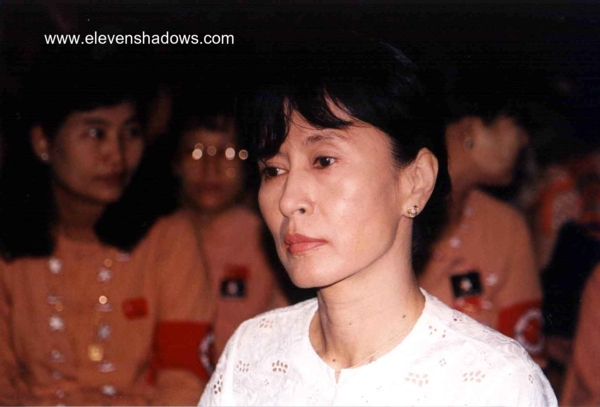 "The
Lady" arrived to much commotion. Several speakers gave speeches in Burmese,
and Burmese literature was handed to us. Paula managed to talk to Aung San
Suu Kyi briefly – an incredible opportunity, given her limited freedom. "The
Lady" arrived to much commotion. Several speakers gave speeches in Burmese,
and Burmese literature was handed to us. Paula managed to talk to Aung San
Suu Kyi briefly – an incredible opportunity, given her limited freedom.
After the meeting, as the gravity of our situation continued
to sink in, we walked out with one of the U.S. embassy employees to make
ourselves feel safer. "I have no control over what happens here," he had
said. "We have no diplomatic relationsip with this country." We knew that,
nodding glumly. As we exited the meeting, many people with cameras started
taking photos of us, their cameras following as we walked.
We quickly flagged down a taxi. However, a man in a white car
followed our every turn. We changed directions several times, but the car
continued following. We finally asked the terrified driver to drop us off at the
U.S. Embassy, eagerly scrambling inside to report to the Marine on duty that we
were being followed. He said that others had reported being followed before, but
remained stoic.
After some minutes, we left the Embassy. The man in the white
car was still there, and rolled behind us on the street slowly, ominously.
We decided to walk to an expensive hotel called The Strand, ordering mixed
drinks and burgers to calm our nerves. We walked back out, looking around.
We no longer saw the white car. Where was he? Why did he drive off?
Where others following? We walked the wrong way down one-way streets and
traipsed through stores to exit the back side, trying to make certain that we were no longer being followed.
The next day, Paula left. However, her phone call from
Singapore several hours later, in a sort of "code" that we had agreed upon
before, left us in cold shock. The airport officials, who had her name on
a list, had demanded to search her belongings, confiscating all her film, books,
and cassettes. Luckily, she had not been detained. But we thought, "If the
Burmese military identified her, surely they're on to us!"
I wanted to escape with at least a few rolls of our film. I
purchased ten rolls of film, shooting one or two pictures in each before
rewinding the film. I then placed these rolls in my lead-lined bag as a decoy.
Lisa and I hid the rest of the film in every crevice of our backpacks, including
dirty socks, aspirin bottles, shirts, shoes, artwork. I even jammed a roll
in each of my shoes, which caused great pain as the day wore on. "What if they
get really upset that we're hiding this?" Lisa asked. But still we did it.
We had nothing of value, nothing inflammatory, and felt odd to hide such
innocuous photos from the military. I locked my backpack several different ways
and hoped for the best.
Still completely dark, we arrived early that morning at the
dimly-lit airport, checked our luggage in, and sat nervously in the waiting room
for two hours watching Bon Jovi videos. We couldn't relax until the plane
had lifted off the ground, one of the most beautiful sounds I've ever heard.
"You have no idea how happy we are to be in India!" I
exclaimed to the Indian immigration official.
Postscript: A month after we left Myanmar, the military
prevented Aung San Suu Kyi from going to an NLD youth rally only 30 km from
Yangon. Aung San Suu Kyi remained in her car for about 11 days—the fourth such
stand-off in the last ten years—before finally being forced to return to her
house. The military then raided the NLD headquarters, carting away documents.
Burma continues to be one of the most brutal regimes in the world while the
world stands idly by, issuing endless litanies of diplomatic terms like “deeply
concerned,” “closely watching,” “monitoring the situation,” “turning a new
page,” and “forcefully urging dialogue.”
Burma
Forum L.A.
Free Burma Coalition
|
Burma 2000
Page 1 of 2


Page 2 - India and Bangkok
Burma Home Page
Eleven Shadows Travel
Page
Contact photographer/musician Ken Lee
|
 Shwedagon
Paya, Yangon (Rangoon), Myanmar (Burma). The original stupa was built
sometime between the 6th and 10th centuries and, according to legend, houses
eight hairs of the Buddha.
Shwedagon
Paya, Yangon (Rangoon), Myanmar (Burma). The original stupa was built
sometime between the 6th and 10th centuries and, according to legend, houses
eight hairs of the Buddha.  Shwedagon
Paya lit up in the evening. I left my tripod in the hotel, so I ended up
taking this picture by balancing the camera on my backpack, which was
resting on a railing.
Shwedagon
Paya lit up in the evening. I left my tripod in the hotel, so I ended up
taking this picture by balancing the camera on my backpack, which was
resting on a railing. One
of the many buddhas at Shwedagon Paya, Yangon, Myanmar. A vast assortment of
smaller temples, shrines, statues and pavilions surround the main building.
One
of the many buddhas at Shwedagon Paya, Yangon, Myanmar. A vast assortment of
smaller temples, shrines, statues and pavilions surround the main building. Lu
Maw, of the Moustache Brothers troupe, in Mandalay. The Moustache Brothers
perform an interesting blend of music, drama, improvisation, and social
commentary/satire known as pwe. Two members of the troupe -- Par Par Lay and
Lu Zaw, Lu Maw’s older brother and cousin, respectively -- were arrested in
1996 after performing at an NLD gathering and telling jokes about the
government. Par Par Lay’s wife travels to the prison every two months to
bring him food, although she is not allowed to see him. A visit to the
nightly performances on 39th St is highly recommended.
Lu
Maw, of the Moustache Brothers troupe, in Mandalay. The Moustache Brothers
perform an interesting blend of music, drama, improvisation, and social
commentary/satire known as pwe. Two members of the troupe -- Par Par Lay and
Lu Zaw, Lu Maw’s older brother and cousin, respectively -- were arrested in
1996 after performing at an NLD gathering and telling jokes about the
government. Par Par Lay’s wife travels to the prison every two months to
bring him food, although she is not allowed to see him. A visit to the
nightly performances on 39th St is highly recommended. A
waterfall near Pyin U Lwin, a town that continues to use stagecoaches left
over from the British occupation of Myanmar.
A
waterfall near Pyin U Lwin, a town that continues to use stagecoaches left
over from the British occupation of Myanmar. Headless
buddhas at a monastery in Hsipaw, Myanmar
Headless
buddhas at a monastery in Hsipaw, Myanmar Mt.
Popa, the Mt. Olympus of nats (spirits). Before King Anawrahta brought
Buddhism to Burma in the 11th century, the Burmese worshipped
nats, spirits who held dominion over specific places, people, and fields of
endeavor. When nats were displaced by buildings or monasteries, the Burmese
often built small shrines to appease them, lest they cause misfortune to
befall the human landowners.
Mt.
Popa, the Mt. Olympus of nats (spirits). Before King Anawrahta brought
Buddhism to Burma in the 11th century, the Burmese worshipped
nats, spirits who held dominion over specific places, people, and fields of
endeavor. When nats were displaced by buildings or monasteries, the Burmese
often built small shrines to appease them, lest they cause misfortune to
befall the human landowners. Bagan.
We bicycled around this spectacular plain of monuments, many over 800 years
old. The area encompasses 40 sq. km. This is often considered to be one of
the most remarkable sites in Myanmar, if not all of Southeast Asia.
Bagan.
We bicycled around this spectacular plain of monuments, many over 800 years
old. The area encompasses 40 sq. km. This is often considered to be one of
the most remarkable sites in Myanmar, if not all of Southeast Asia. Walking
between villages near Nyaungshwe, Inle Lake, Myanmar. The Inle Lake area
sits in a green, picturesque valley flanked by tall mountains in the Shan
State of Myanmar. The lake itself features floating gardens and charming
villages built entirely on stilts, inhabited by Intha people. The incredibly
tasty mangos, bananas, and tomatoes, as well as the village life, reminded
me a little of Dal Lake in Srinagar. Rather strange is how the Inthas paddle
their boats—standing at the stern on one leg while wrapping the other leg
around the oar to offer relief for the arms. Inle Lake offers beautiful
mountain hikes, wonderful food, and very friendly people, and was perhaps
our favorite location in Myanmar.
Walking
between villages near Nyaungshwe, Inle Lake, Myanmar. The Inle Lake area
sits in a green, picturesque valley flanked by tall mountains in the Shan
State of Myanmar. The lake itself features floating gardens and charming
villages built entirely on stilts, inhabited by Intha people. The incredibly
tasty mangos, bananas, and tomatoes, as well as the village life, reminded
me a little of Dal Lake in Srinagar. Rather strange is how the Inthas paddle
their boats—standing at the stern on one leg while wrapping the other leg
around the oar to offer relief for the arms. Inle Lake offers beautiful
mountain hikes, wonderful food, and very friendly people, and was perhaps
our favorite location in Myanmar. Cycle
rickshaws are a common method of transportation in Inle Lake and much of
Myanmar. Automobile traffic is still rather light.
Cycle
rickshaws are a common method of transportation in Inle Lake and much of
Myanmar. Automobile traffic is still rather light. Besieged
by hawkers in souvenir boats, Inle Lake, Myanmar.
Besieged
by hawkers in souvenir boats, Inle Lake, Myanmar. What
is the sound of one cat jumping? This is Nga Phe Kyaung, also known as
Jumping Cat Monastery, in Inle Lake. When not meditating on the nature of
emptiness, monks teach cats to jump through hoops.
What
is the sound of one cat jumping? This is Nga Phe Kyaung, also known as
Jumping Cat Monastery, in Inle Lake. When not meditating on the nature of
emptiness, monks teach cats to jump through hoops. We
visited several Pa-O villages and a meditation cave during a very
picturesque 13.5-mile hike in the mountains east of Nyaungshwe. Many of the
villagers, such as the woman here, carry food they’ve grown to the larger
market in Nyaungshwe. Some walk as much as 20 miles with 60 pounds on their
backs – while wearing flip-flops.
We
visited several Pa-O villages and a meditation cave during a very
picturesque 13.5-mile hike in the mountains east of Nyaungshwe. Many of the
villagers, such as the woman here, carry food they’ve grown to the larger
market in Nyaungshwe. Some walk as much as 20 miles with 60 pounds on their
backs – while wearing flip-flops. Pa-O
boy in a mountain village near Nyaungshwe, showing a particular fascination
with my camera.
Pa-O
boy in a mountain village near Nyaungshwe, showing a particular fascination
with my camera.
 Like
this young monk, most Burmese belong to the Theravada sect of Buddhism.
After one of the monsoon rains over the valley and Inle Lake, we were
rewarded with a rainbow and a spectacular sunset over the mountains, bathing
everything in golden light.
Like
this young monk, most Burmese belong to the Theravada sect of Buddhism.
After one of the monsoon rains over the valley and Inle Lake, we were
rewarded with a rainbow and a spectacular sunset over the mountains, bathing
everything in golden light. Market
in the town of Pindaya.
Market
in the town of Pindaya. Outside
a Hindu temple in Yangon, Myanmar, a girl sells garlands to be given as
offerings. About 1.5 percent of Burmese are Hindu, and most are of Indian
descent.
Outside
a Hindu temple in Yangon, Myanmar, a girl sells garlands to be given as
offerings. About 1.5 percent of Burmese are Hindu, and most are of Indian
descent. Yangon,
Burma.
Yangon,
Burma. Aung
San Suu Kyi, Nobel Peace Prize winner, leader of the National League for
Democracy, and the democratically elected leader of Myanmar. After being
under house arrest for six years, she now has limited freedom but cannot
leave Yangon. Her father, General Aung San, was the first leader of Burma’s
independence movement and was assassinated in 1947.
Aung
San Suu Kyi, Nobel Peace Prize winner, leader of the National League for
Democracy, and the democratically elected leader of Myanmar. After being
under house arrest for six years, she now has limited freedom but cannot
leave Yangon. Her father, General Aung San, was the first leader of Burma’s
independence movement and was assassinated in 1947. "The
Lady" arrived to much commotion. Several speakers gave speeches in Burmese,
and Burmese literature was handed to us. Paula managed to talk to Aung San
Suu Kyi briefly – an incredible opportunity, given her limited freedom.
"The
Lady" arrived to much commotion. Several speakers gave speeches in Burmese,
and Burmese literature was handed to us. Paula managed to talk to Aung San
Suu Kyi briefly – an incredible opportunity, given her limited freedom.


